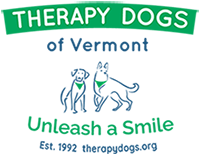—Isa, German Shepherd & therapy dog (typed by Deb Helfrich, Vice President)
QUESTION: Dear Isa, is it ever okay for a therapy dog to be off-leash when working? Also, what’s your opinion on someone other than the certified handler handling a therapy dog? I’ve gone to a few therapy dog events and seen some dogs off leash or being walked around by children who wanted to walk a therapy dog. – Waldo, the Golden Retriever
ANSWER: Excellent questions!! Our guidelines do in fact say, “Dogs must be on a leash (4’ or less) unless participating in exercises that necessitate being off lead (such as obedience demonstrations), at which time they must be closely supervised.” So, as a rule, yes, your handler should always be on the end of your leash (after all, you’ve got to keep your human on leash and well-behaved, right? Wink). Sure, there are some occasions when being off leash is appropriate—say, when you are giving an obedience demonstration or letting someone throw a ball for you. No matter what, your handler should always be in control, right there with you, and closely supervising. Safety is always the top concern!
Now, the WHO is on the other end of the leash is a murkier issue. Clearly, there should not be another dog, cat, or chicken (or other barnyard pal) holding your leash (unless of course, they were tested and certified with you by an official TDV tester). Just kidding, how would a chicken know what a proper heel is anyway? Do chickens even have heels? You know, I like to chase chickens, personally—love that sqeakie-toy noise they make when they see you coming in like lightning and the feathers are so pretty as they go “poof!” into the air from the chicken! But, back to your question…
Remember that you and your handler were tested as a TEAM. That means you both have proven you can work together as a therapy dog team. Since the most effective working relationships involve knowing and respecting each other, there’s no better team than YOU and your HANDLER. Your person knows you, your reactions, your needs—and you know and trust your person. This is the basis for a safe and wonderful therapy dog visiting experience. Even though another person may be neato and fun, they might not know you and how to work with you. Even worse, an inexperienced child or handler may jerk on your leash or not know how to politely ask you to sit or heel, so that’s no fun for you! And, they may not know TDV’s rules or the rules of the facility you’re visiting—or how to properly make a therapy dog visit. So, with all that said, your handler should be the one on the end of your leash.
Now, sometimes a child or person may want to walk you as part of a visit. I think we can apply the off-leash example here too—your handler should always be in control, nearby, and closely supervising.
Waldo, hope that helps. Let me know if you want to go chicken-chasing sometime! —Isa
“Ask Isa” is a Q&A column appearing in the Therapy Dogs of Vermont quarterly newsletter. It is reproduced here for Therapy Dogs of Vermont website readers. It is not a substitute for seeking proper veterinary, training, or behavioral advice from professionals!
